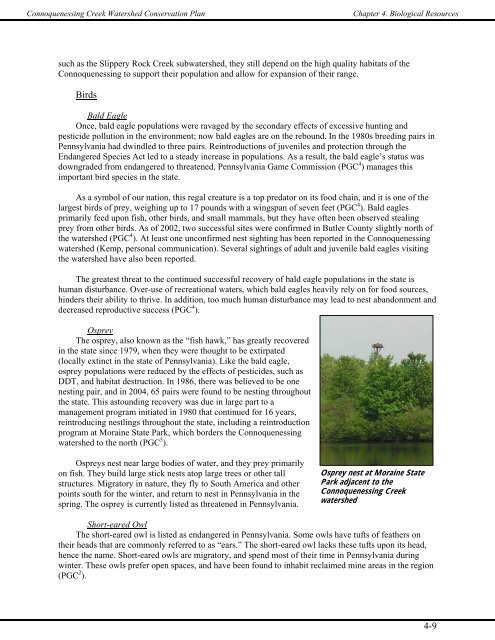CHAPTER 4 - Western Pennsylvania Conservancy
CHAPTER 4 - Western Pennsylvania Conservancy
CHAPTER 4 - Western Pennsylvania Conservancy
You also want an ePaper? Increase the reach of your titles
YUMPU automatically turns print PDFs into web optimized ePapers that Google loves.
Connoquenessing Creek Watershed Conservation Plan<br />
Chapter 4. Biological Resources<br />
such as the Slippery Rock Creek subwatershed, they still depend on the high quality habitats of the<br />
Connoquenessing to support their population and allow for expansion of their range.<br />
Birds<br />
Bald Eagle<br />
Once, bald eagle populations were ravaged by the secondary effects of excessive hunting and<br />
pesticide pollution in the environment; now bald eagles are on the rebound. In the 1980s breeding pairs in<br />
<strong>Pennsylvania</strong> had dwindled to three pairs. Reintroductions of juveniles and protection through the<br />
Endangered Species Act led to a steady increase in populations. As a result, the bald eagle’s status was<br />
downgraded from endangered to threatened. <strong>Pennsylvania</strong> Game Commission (PGC 4 ) manages this<br />
important bird species in the state.<br />
As a symbol of our nation, this regal creature is a top predator on its food chain, and it is one of the<br />
largest birds of prey, weighing up to 17 pounds with a wingspan of seven feet (PGC 4 ). Bald eagles<br />
primarily feed upon fish, other birds, and small mammals, but they have often been observed stealing<br />
prey from other birds. As of 2002, two successful sites were confirmed in Butler County slightly north of<br />
the watershed (PGC 4 ). At least one unconfirmed nest sighting has been reported in the Connoquenessing<br />
watershed (Kemp, personal communication). Several sightings of adult and juvenile bald eagles visiting<br />
the watershed have also been reported.<br />
The greatest threat to the continued successful recovery of bald eagle populations in the state is<br />
human disturbance. Over-use of recreational waters, which bald eagles heavily rely on for food sources,<br />
hinders their ability to thrive. In addition, too much human disturbance may lead to nest abandonment and<br />
decreased reproductive success (PGC 4 ).<br />
Osprey<br />
The osprey, also known as the “fish hawk,” has greatly recovered<br />
in the state since 1979, when they were thought to be extirpated<br />
(locally extinct in the state of <strong>Pennsylvania</strong>). Like the bald eagle,<br />
osprey populations were reduced by the effects of pesticides, such as<br />
DDT, and habitat destruction. In 1986, there was believed to be one<br />
nesting pair, and in 2004, 65 pairs were found to be nesting throughout<br />
the state. This astounding recovery was due in large part to a<br />
management program initiated in 1980 that continued for 16 years,<br />
reintroducing nestlings throughout the state, including a reintroduction<br />
program at Moraine State Park, which borders the Connoquenessing<br />
watershed to the north (PGC 5 ).<br />
Ospreys nest near large bodies of water, and they prey primarily<br />
on fish. They build large stick nests atop large trees or other tall<br />
structures. Migratory in nature, they fly to South America and other<br />
points south for the winter, and return to nest in <strong>Pennsylvania</strong> in the<br />
spring. The osprey is currently listed as threatened in <strong>Pennsylvania</strong>.<br />
Osprey nest at Moraine State<br />
Park adjacent to the<br />
Connoquenessing Creek<br />
watershed<br />
Short-eared Owl<br />
The short-eared owl is listed as endangered in <strong>Pennsylvania</strong>. Some owls have tufts of feathers on<br />
their heads that are commonly referred to as “ears.” The short-eared owl lacks these tufts upon its head,<br />
hence the name. Short-eared owls are migratory, and spend most of their time in <strong>Pennsylvania</strong> during<br />
winter. These owls prefer open spaces, and have been found to inhabit reclaimed mine areas in the region<br />
(PGC 2 ).<br />
4-9














